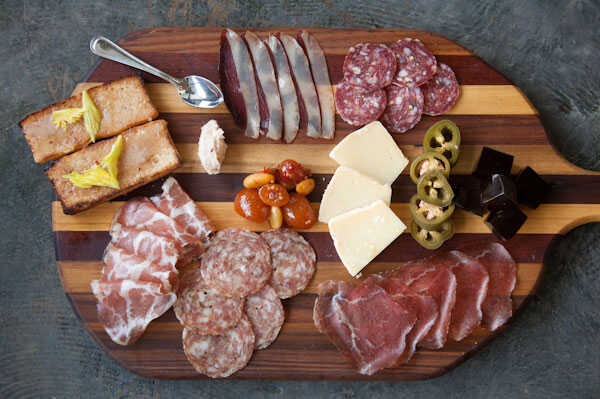
A charcutaria ou charcuterie, que é o termo original do francês, é uma técnica de preparação de alimentos que envolve o processamento e a conservação de carne, geralmente por meio de métodos como salga, cura, defumação e fermentação. O termo “charcuterie” é de origem francesa e se refere a uma variedade de produtos de carne curada e preparada, como presunto, salame, salsichas, patês e outros produtos de carne.
A charcutaria é apreciada por sua combinação de sabores intensos e texturas diversas, e é frequentemente servida como um prato de aperitivo ou como parte de uma tábua de queijos e frios. A apresentação desempenha um papel importante na charcutaria, e muitas vezes é montada de forma artística em tábuas ou pratos, combinando carnes curadas com queijos, frutas, nozes, pães e condimentos.
Alguns dos produtos de charcuterie mais conhecidos incluem:
Presunto cru: O presunto curado, ou presunto cru como também é conhecido, é uma das estrelas da charcutaria, com variedades como o presunto de Parma, presunto ibérico e presunto serrano. É a iguaria mais nobre e custosa da charcuterie, e pode levar até 3 anos para ficar pronta para o consumo.
Salame: Existem inúmeras variedades de salame, incluindo o salame italiano, que geralmente é maturado por mais tempo e mais rígido, o salame de colonial, que é mais macio e tem pouco tempo de maturação, o salame hamburguês que passa por defumação e muitos outros, cada um com seu sabor característico.
Salsichas: Salsichas curadas, como chorizo, salsichas emulsionadas de estilo alemão, como as salsichas de cachorro quente(hotdogs, vinas ou frankfurters) que estamos bastante acostumados.
Patês: Patês de fígado, como o foie gras, são frequentemente incluídos em pratos e tábuas de charcuterie.
Terrines: Terrines são preparações de carne picada e outros ingredientes, frequentemente assados em uma forma de pão ou bolo, e podem incluir carne de porco, pato, carne de vitela e outros ingredientes.
Mortadela e Presutos cozidos: Mortadela e Presunto cozido são bem comuns nos lanches e cafés da manhã no Brasil, podem ser de porco, frango, gado ou uma mistura de carnes.
Linguiças: Linguiça é indispensável em qualquer churrasco, é um embutido muito tradicional e que pode conter uma variedade imensa de carnes e outros ingredientes, como queijos, ervas e até legumes.
Rillettes: Rillettes são carnes cozidas lentamente e desfiadas, geralmente servidas em potes e espalhadas em pães.
A charcutaria é uma tradição culinária que remonta séculos e é apreciada em todo o mundo. É uma maneira deliciosa de explorar uma variedade de sabores e combinações de ingredientes, tornando-a uma escolha popular para refeições informais, eventos e comemorações especiais.
História da Charcutaria ou Charcuterie
A charcuterie ou charcutaria tem raízes antigas e sua origem remonta a diferentes culturas e épocas ao longo da história. Ela evoluiu a partir de métodos de conservação de carne desenvolvidos por diferentes sociedades ao longo do tempo. Aqui estão algumas informações sobre a origem da charcuterie em diferentes regiões:
França: O termo “charcuterie” tem origem francesa e é derivado de carne(chair) e cozido(cuit) e da palavra “charcutier”, que se refere ao açougueiro ou produtor de produtos de carne. Na França, a charcuterie ganhou destaque durante a Idade Média, quando os açougueiros desenvolveram métodos de conservação de carne, como a cura e a fermentação, para prolongar a vida útil das carnes. Os produtos de charcuterie se tornaram parte integrante da culinária francesa, e a França é famosa por suas variedades de patês, salames e presuntos.
Itália: A Itália também tem uma longa tradição de charcuterie, com produtos como o presunto de Parma e uma grande variedade de salames, como o salame milanês e o salame de Gênova. A culinária italiana é conhecida por seu uso criativo de carnes curadas, que são usadas em sanduíches, pizzas e muitos outros pratos tradicionais.
Espanha: Na Espanha, a charcuteria é conhecida como “charcutería” e é uma parte importante da gastronomia espanhola. O presunto ibérico, especialmente o famoso Jamón Ibérico, é um dos produtos de charcuterie mais apreciados e caros do mundo. Além disso, a Espanha é conhecida por suas salsichas curadas, como o chorizo e o salchichón.
Outras regiões: A charcuterie não é exclusiva da França, Itália e Espanha. Muitas outras culturas ao redor do mundo têm suas próprias tradições de alimentos curados e preparados. Por exemplo, a Alemanha é famosa por suas salsichas, como a bratwurst e a mettwurst, enquanto a China tem uma longa história de preservação de carne, incluindo o uso de métodos de secagem e defumação.
Evolução tecnológica da charcuterie ou charcutaria
Uso de culturas bacterianas selecionadas: As culturas bacterianas selecionadas, ou culturas starter, desempenham um papel fundamental na charcuterie, especialmente em produtos como salames, salsichas e produtos fermentados. Essas culturas são adicionadas intencionalmente às carnes para iniciar processos de fermentação controlada. Elas convertem açúcares em ácido láctico e outras substâncias, criando um ambiente ácido que inibe o crescimento de bactérias indesejadas. Além disso, essas culturas contribuem para o desenvolvimento de sabores característicos e texturas em produtos curados.
A preservação de carnes por métodos de charcuterie evoluiu ao longo do tempo com avanços tecnológicos que melhoraram a eficiência e a segurança dos processos. Aqui estão cinco evoluções tecnológicas na preservação de carnes por métodos de charcuterie:
Refrigeração e refrigeração controlada: A invenção de sistemas de refrigeração, como geladeiras e câmaras frigoríficas, permitiu o armazenamento seguro de carnes frescas por períodos prolongados. Isso reduziu a dependência de métodos tradicionais de conservação, como a cura e a fermentação, para preservação de curto prazo.
Uso de nitrito de sódio e nitrato de sódio: A adição de nitrito de sódio e nitrato de sódio, geralmente em mistura denominada sal de cura, em produtos de carne curada, como bacon e presunto, desempenha um papel importante na prevenção do crescimento de bactérias patogênicas, além de dar cor e sabor característicos a esses produtos.
Embalagens a vácuo: A tecnologia de embalagem a vácuo permite remover o ar da embalagem, criando um ambiente anaeróbico que inibe o crescimento de microrganismos responsáveis pela deterioração dos alimentos. Isso é amplamente utilizado na preservação de carnes curadas e produtos de charcuterie.
Desidratação controlada e defumação: A desidratação e a defumação são métodos tradicionais de preservação usados na charcuterie. A evolução dessas técnicas inclui o uso de equipamentos modernos para controle preciso da temperatura e da umidade durante o processo de secagem e defumação, garantindo a segurança alimentar.
Uso de culturas fúngicas: As culturas fúngicas(mold), como Penicillium nalgiovense e Penicillium candidum, são utilizadas intencionalmente na charcuterie para promover o crescimento de mofo branco ou azul em produtos específicos. Isso é comum em salames mofados, como o salame branco, onde o mofo desempenha um papel na proteção da carne contra bactérias indesejadas e no desenvolvimento de sabores característicos. Além disso, algumas culturas fúngicas contribuem para a formação de uma casca protetora em produtos curados, ajudando a manter a umidade interna e a textura.
Produtos da Charcutaria brasileira
O Brasil possui sua própria tradição de preparação de carnes e alimentos curados que, embora tenha influências de diversas culturas, predominantemente europeias, tem características distintas. Segue relação com alguns dos produtos da charcutaria do Brasil.
Linguiça calabresa: A linguiça calabresa é um tipo de linguiça picante que tem suas raízes na culinária italiana. Ela é muito popular no Brasil, especialmente na culinária do sul e sudeste do país, onde é usada em feijoadas, pizzas, tábuas, grelhada com cebola em chapas e outras muitas preparações.
Linguiça toscana: A linguiça toscana é uma variedade de linguiça fresca que recebeu influência da culinária italiana. Ela é extremamente comum em churrascos.
Paio: O paio é um embutido defumado que tem influência da culinária portuguesa e é muito apreciado no Brasil. É frequentemente incluído em feijoadas e consumido como aperitivo ou como parte de tira-gostos.
Linguicinha cuiabana: Originária do estado de Mato Grosso, a linguiça cuiabana é uma linguiça típica da região central do Brasil. Ela é temperada com leite e ingredientes locais, como a pimenta-de-cheiro, o que lhe confere um sabor característico.
Carne-seca serenada e charque: A carne-seca é a carne de boi salgada e desidratada, e tem sido amplamente utilizada na culinária brasileira há séculos. Ela é um ingrediente essencial em pratos populares como a feijoada e o arroz de carreteiro.
É importante observar que muitos produtos da charcuteria brasileira têm influência de diferentes tradições culinárias, especialmente a europeia pela imigração, e evoluíram para atender aos gostos e ingredientes disponíveis no país. Embora esses produtos tenham características distintas, eles fazem parte de uma rica tradição culinária brasileira.




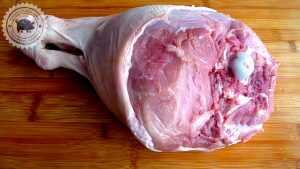
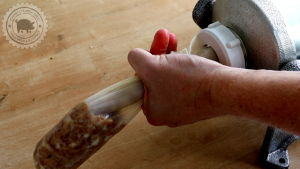
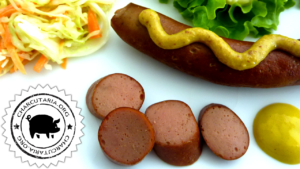
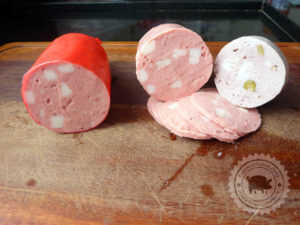
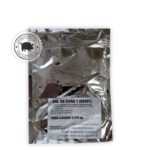

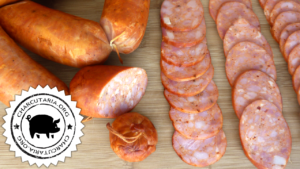
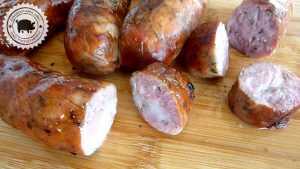
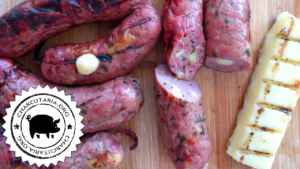
Deus água na boca, acho que dar um pouquinho de trabalho, porem o resultado dessa receita é sensacional.